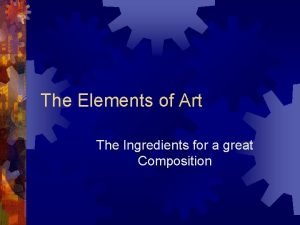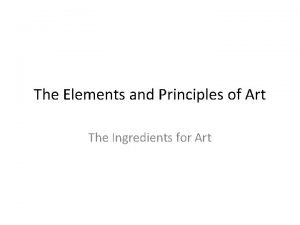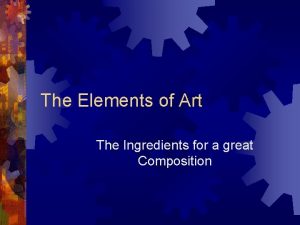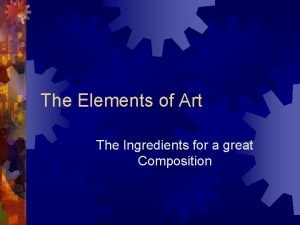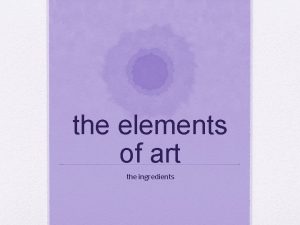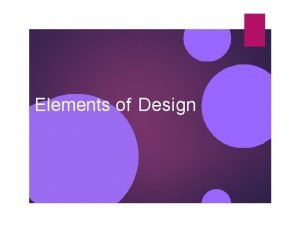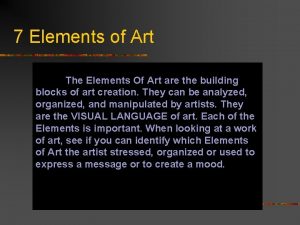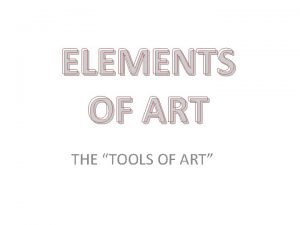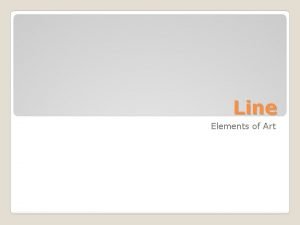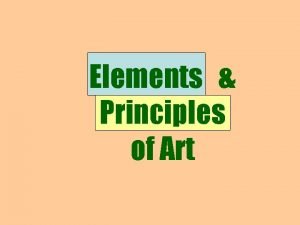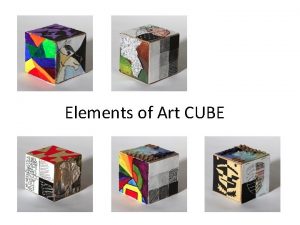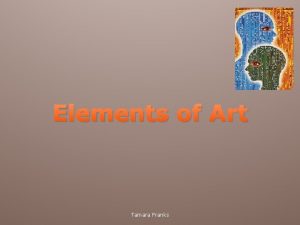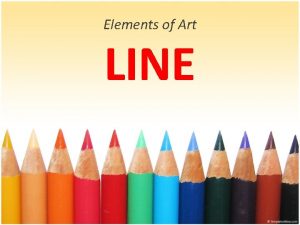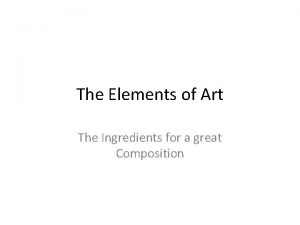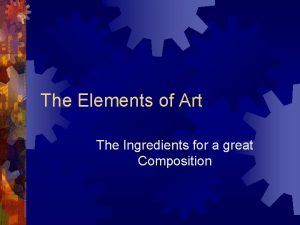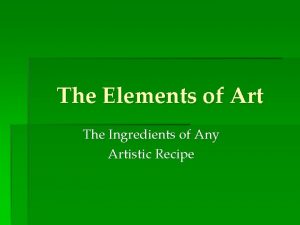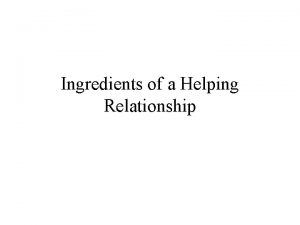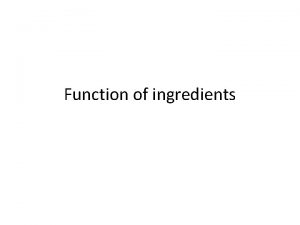The Elements of Art The Ingredients for a















































- Slides: 47

The Elements of Art The Ingredients for a great Composition

What are the elements of art? The Elements of Art are the “tools” that artists use to make art. There are 7 of them: Line Value Texture Shape Form Space Color

Art Elements ® Artists use a combination of these elements to create art ® Not all elements are always used ® Sometimes one or two elements are the most important

Line, Colour, Shape

Value, Space, Texture

Shape, Colour

Line A line is a path that a point takes through space. Lines can be thick, thin, dotted or solid. They can make straight movements, zig-zags, waves or curls. They may be horizontal vertical diagonal

Horizontal lines are generally restful, like the horizon, where the sky meets land

Vertical lines seem to be reaching, so they may seem inspirational like tall majestic trees or church steeples

Diagonal lines tend to be disturbing. They suggest decay or chaos like lightening or falling trees

Lines can convey emotion as well. They may show excitement, anger, calmness, tension, happiness and many other feelings. Because of this, some are said to be expressive.

Expressive Lines tend to be found in nature and are very organic

Constructive lines Other lines that are very measured, geometric, directional and angular are called Constructive lines. They tend to appear to be man-made because of their precision.

Shape is created when a line becomes connected and encloses space. It is the outline or outward appearance of something. Shapes are 2 Dimensional (2 -D) which means there are 2 ways they can be measured. You can measure its HEIGHT and its WIDTH. There are two basic types of shape.

The 2 types of shape Geometric shapes have smooth even edges and are measurable. The include the square, the circle, the triangle and the rectangle.

Second type of shape Organic shapes have more complicated edges and are usually found in nature. Leaves, flowers, ameba, etc.

Form A Form is a shape that has become 3 Dimensional (3 -D) Form has HEIGHT, WIDTH and DEPTH--which is the 3 rd dimension. Depth shows the thickness of the object. Forms are NOT flat like shapes are!

Turning Shapes into Forms A triangle becomes a cone or a pyramid A square becomes a cube

Turning Shapes into Forms A rectangle can become a box or a cylinder In order to turn a circle into a sphere, you must shade it. You can’t add another side to it!

Value is the lightness or darkness of a color. Value makes objects appear more real because it imitates natural light. When showing value in a work of art, you will need a LIGHT SOURCE. A light source is the place where the light is coming from, the darkest areas are always on the opposite side of the light.

Value In order to have a successful drawing, you will need to show a full value range, which means that there are very light areas, middle tones, and very dark areas. This is a way of giving a work of art Contrast. In drawing value can be added several ways:

Ways value can be added: Cross-hatching is when you use irregular lengths of parallel lines that cross over each other diagonally. The closer together the lines are placed, the darker the value.

Ways value can be added Stippling is the use of dots to create shade. This is accomplished by placing dots very close together to create dark values and farther apart to create lighter values.

Ways value can be added Soft shading is when you use your pencil to create soft gradual movements from one value to the next using full value range.

Color can add interest and reality to artwork. The use of a 12 -step color wheel will help us understand color more effectively. When light is reflected through a prism, colors can be seen These colors are: Red, Yellow, Orange, Green, Indigo, Blue and Violet Remember the anagram: ROY G BIV

Color Wheel A long time ago, artists decided that these colors would be more useful to them if they were placed in a wheel fashion. This became known as the color wheel

Color There are 3 primary colors: Red, Yellow and Blue These colors are primary for 2 reasons: 1. They can’t be mixed to be made 2. They make all the other colors on the color wheel

Color When you mix 2 primary colors together, you get a secondary color. For example: Red and Yellow=Orange Red and Blue=Violet Yellow and Blue= Green

Color When you mix a primary and a secondary color together you get an intermediate (or tertiary) color For example: Red and Orange= Red-Orange Yellow and Green=Yellow-Green Blue and Green=Blue-Green Red and Violet=Red-Violet Yellow and Orange=Yellow-Orange Blue and Violet=Blue-Violet

Color Schemes Color is divided into groups based on the way they are placed on the color wheel: 3 -4 colors “next-door-neighbors” to each other creates an analogous color scheme

Color schemes 2 colors that are directly opposite each other (going across the center) creates a complimentary color scheme

Color Schemes A Split-Complimentary color scheme is a complimentary color and the two colors on either side of its compliment.

Color Schemes A Triadic color scheme uses 3 colors that are equally spaced apart on the color wheel

Color Schemes When you use only one color plus its tints and shades, you are using a monochromatic color scheme A tint is a color plus white A shade is a color plus black

Colors have temperatures Colors can convey emotion and feelings too. Have your ever felt “blue? ” Been “green’ with envy? Called a “yellow” coward? It is important that artists understand the effects of color when they are trying to get the viewers of their art to feel a particular way.

Color Temperatures Warm colors are those that have Reds, Yellows and Oranges. Warm colors seem to advance (or come forward) in an artwork. Cool colors are those that have Blues, Greens and Violets. Cool colors seem to recede (or go back into) an artwork.

Texture is the way the surface of an object actually feels. In the artistic world, we refer to two types of texture---tactile and implied

Tactile (or Real) Texture is the way the surface of an object actually feels. Examples would be sandpaper, cotton balls, tree bark, puppy fur, etc.

Implied Texture is the way the surface of an object looks like it feels. This is the type of texture that artists use when they draw and paint. Textures may look rough, fuzzy, gritty, or scruffy, but can’t actually be felt.

Space is basically divided into 3 parts: Foreground, Middle Ground and Background Generally, the background area is considered to be the upper 1/3 of the picture plane. The middle ground area is considered to be the middle 1/3 of the picture plane. The foreground area is considered to be the lower 1/3 of the picture plane.

Space can be shallow or deep depending on what the artist wants to use. Shallow space is used when the artist has objects very close to the viewer.

Space Deep Space may show objects up close but objects are shown far away too.

Space Positive and Negative space is a way that an artwork is divided. When planning a work of art, both areas must be examined so that they balance one another. Drawing items running off the page and zooming in on objects are ways to create visual interest within a work.

Space Positive space is the actual object(s) within the artwork Negative Space is the area in and around the objects. It is the “background” and it contributes to the work of art---you can’t have positive space without negative space

Space Perspective is also a way of showing space in a work of art. Perspective is when the artist uses a vanishing point on the horizon and then creates a sense of deep space by showing objects getting progressively smaller as they get closer to the vanishing point.

Space Objects may overlap as well. When objects are overlapped it is obvious that enough space had to be in the picture to contain all the objects that have been included

The Elements of Art in Review The Elements of Art are the “tools” that artists use to make art. They are the basic “foundation” of a good composition Line Value Texture Shape Form Space Color
 The ingredients of art
The ingredients of art The ingredients of art
The ingredients of art Generally restful like the horizon where the sky meets land
Generally restful like the horizon where the sky meets land Generally restful like the horizon where the sky meets
Generally restful like the horizon where the sky meets Kontinuitetshantering
Kontinuitetshantering Typiska novell drag
Typiska novell drag Tack för att ni lyssnade bild
Tack för att ni lyssnade bild Returpilarna
Returpilarna Varför kallas perioden 1918-1939 för mellankrigstiden
Varför kallas perioden 1918-1939 för mellankrigstiden En lathund för arbete med kontinuitetshantering
En lathund för arbete med kontinuitetshantering Adressändring ideell förening
Adressändring ideell förening Tidbok för yrkesförare
Tidbok för yrkesförare A gastrica
A gastrica Förklara densitet för barn
Förklara densitet för barn Datorkunskap för nybörjare
Datorkunskap för nybörjare Stig kerman
Stig kerman Debatt mall
Debatt mall Delegerande ledarstil
Delegerande ledarstil Nyckelkompetenser för livslångt lärande
Nyckelkompetenser för livslångt lärande Påbyggnader för flakfordon
Påbyggnader för flakfordon Vätsketryck formel
Vätsketryck formel Publik sektor
Publik sektor Lyckans minut erik lindorm analys
Lyckans minut erik lindorm analys Presentera för publik crossboss
Presentera för publik crossboss Argument för teckenspråk som minoritetsspråk
Argument för teckenspråk som minoritetsspråk Vem räknas som jude
Vem räknas som jude Treserva lathund
Treserva lathund Epiteltyper
Epiteltyper Bästa kameran för astrofoto
Bästa kameran för astrofoto Centrum för kunskap och säkerhet
Centrum för kunskap och säkerhet Programskede byggprocessen
Programskede byggprocessen Mat för unga idrottare
Mat för unga idrottare Verktyg för automatisering av utbetalningar
Verktyg för automatisering av utbetalningar Rutin för avvikelsehantering
Rutin för avvikelsehantering Smärtskolan kunskap för livet
Smärtskolan kunskap för livet Ministerstyre för och nackdelar
Ministerstyre för och nackdelar Tack för att ni har lyssnat
Tack för att ni har lyssnat Vad är referatmarkeringar
Vad är referatmarkeringar Redogör för vad psykologi är
Redogör för vad psykologi är Borstål, egenskaper
Borstål, egenskaper Atmosfr
Atmosfr Borra hål för knoppar
Borra hål för knoppar Vilken grundregel finns det för tronföljden i sverige?
Vilken grundregel finns det för tronföljden i sverige? Varians formel
Varians formel Tack för att ni har lyssnat
Tack för att ni har lyssnat Steg för steg rita
Steg för steg rita Verksamhetsanalys exempel
Verksamhetsanalys exempel Tobinskatten för och nackdelar
Tobinskatten för och nackdelar
